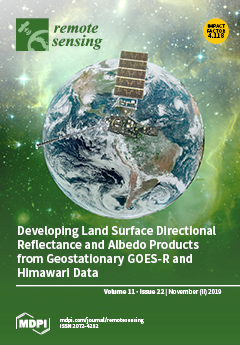The measurement error of differential reflectivity (Z
DR), especially systematic Z
DR bias, is a fundamental issue for the application of polarimetric radar data. Several calibration methods have been proposed and applied to correct Z
DR bias. However, recent studies have shown
[...] Read more.
The measurement error of differential reflectivity (Z
DR), especially systematic Z
DR bias, is a fundamental issue for the application of polarimetric radar data. Several calibration methods have been proposed and applied to correct Z
DR bias. However, recent studies have shown that Z
DR bias is time-dependent and can be significantly different on two adjacent days. This means that the frequent monitoring of Z
DR bias is necessary, which is difficult to achieve with existing methods. As radar sensitivity has gradually been enhanced, large amounts of online solar echoes have begun to be observed in volume-scan data. Online solar echoes have a high frequency, and a known theoretical value of Z
DR (0 dB) could thus allow the continuous monitoring of Z
DR bias. However, online solar echoes are also affected by low signal-to-noise ratio and precipitation attenuation for short-wavelength radar. In order to understand the variation of Z
DR bias in a C-band polarimetric radar at the Nanjing University of Information Science and Technology (NUIST-CDP), we analyzed the characteristics of online solar echoes from this radar, including the daily frequency of occurrence, the distribution along the radial direction, precipitation attenuation, and fluctuation caused by noise. Then, an automatic method based on online solar echoes was proposed to monitor the daily Z
DR bias of the NUIST-CDP. In the proposed method, a one-way differential attenuation correction for solar echoes and a maximum likelihood estimation using a Gaussian model were designed to estimate the optimal daily Z
DR bias. The analysis of three months of data from the NUIST-CDP showed the following: (1) Online solar echoes occurred very frequently regardless of precipitation. Under the volume-scan mode, the average number of occurrences was 15 per day and the minimum number was seven. This high frequency could meet the requirements of continuous monitoring of the daily Z
DR bias under precipitation and no-rain conditions. (2) The result from the proposed online solar method was significantly linearly correlated with that from the vertical pointing method (observation at an elevation angle of 90°), with a correlation coefficient of 0.61, suggesting that the proposed method is feasible. (3) The day-to-day variation in the Z
DR bias was relatively large, and 32% of such variations exceeded 0.2 dB, meaning that a one-time calibration was not representative in time. Accordingly, continuous calibration will be necessary. (4) The Z
DR bias was found to be largely influenced by the ambient temperature, with a large negative correlation between the Z
DR bias and the temperature.
Full article





